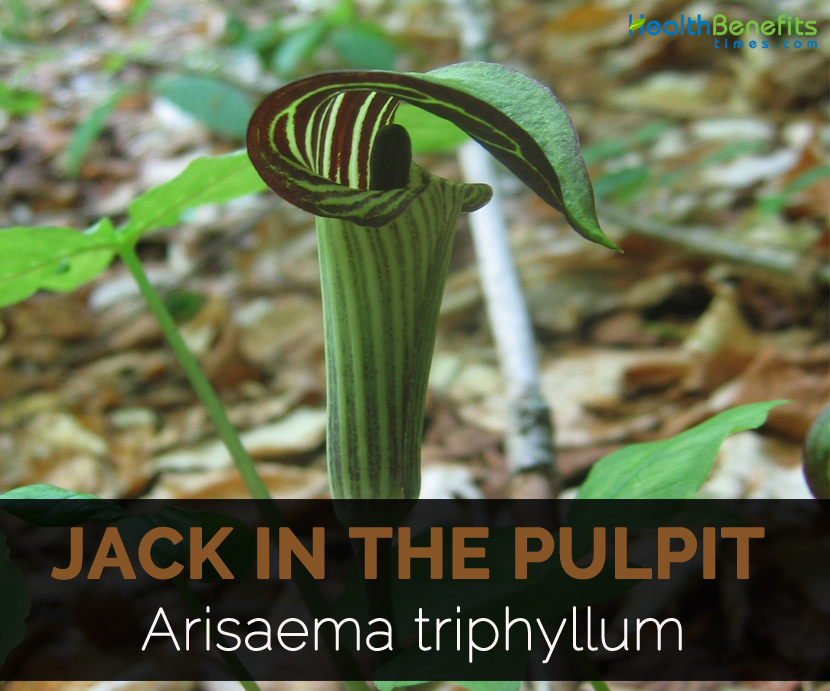| Jack in the pulpit Quick Facts | |
|---|---|
| Name: | Jack in the pulpit |
| Scientific Name: | Arisaema triphyllum |
| Origin | Eastern North America, occurring in moist woodlands and thickets from Nova Scotia west to Minnesota, and south to southern Florida and Texas. |
| Colors | Shiny green |
| Shapes | 1 cm wide berries |
Facts of Jack in the pulpit
| Name | Jack in the pulpit |
|---|---|
| Scientific Name | Scientific Name |
| Native | Eastern North America, occurring in moist woodlands and thickets from Nova Scotia west to Minnesota, and south to southern Florida and Texas. |
| Common/English Name | Dragonroot, Jack In The Pulpit, Indian Turnip, Bog onion, American wake robin, Brown dragon, Wild turnip, Indian turnip, Indian onion, Marsh turnip, Swamp turnip, Meadow turnip, Pepper turnip, Wild pepper, Bog onion, Arum, American arum, Wake robin, Dragon root, Aronknolle |
| Name in Other Languages | English: Indian-turnip, Jack in the pulpit, Jack-in-the-pulpit, Indian Jack-in-the-pulpit, Indian turnip; German: Dreiblättriger Feuerkolben; French: Petit prêcheur, Arisème petit-prêcheur, Ariséma rouge-foncé, Gouet; |
| Plant Growth Habit | Herbaceous perennial plant |
| Plant Size | 30–65 centimetres (12–26 in) in height |
| Fruit shape & size | 1 cm wide berries |
| Fruit color | Shiny green |
| Seed | White to light tan |
| Fruit Season | Late summer and fall |
Flower
Flowers on the club like spadix within hood are grouped atthe base of spadix. The spath or hood is 4-7 inches long which is striped with pinkish purple, brown and green. Fruit forms in clusters on stalk separate from the plant berries which are small and red that is edible.
Culinary uses
- Roots are boiled, sliced and dried for months and consumed like potato chips, crumbled into cereals or ground into flour for making biscuits, cakes and breads.
- Tubers are dried and cooked before consumption.
- Pound it into powder.
Medicinal uses
- The plant is used by Cherokees to treat headache, skin diseases, snake bites, joint aches, open sores and muscle pain.
- Use it for treating tetterworm, ringworm, boils and open sores.
- Tea prepared from Jack in the pulpit is used as stimulant, diaphoretic, expectorant and halt colds and coughs.
- Chippewa use it to provide relief from sore eyes.
- Apply the root as a poultice on headaches, rheumatism, scrofulous sores, ringworm and abscesses.
- Root decoction is used as a wash for sore eyes.
- Native American Indians use the root as contraceptive. 1 teaspoonful of dried powdered root in cold water helps to prevent conception for a week and 2 teaspoonfuls in hot water helps to induce permanent sterility.
Precautions
- It causes the symptoms such as burning in mouth and throat, diarrhea, nausea and vomiting, slurred speech, teary eyes, blistering and swelling in the mouth.
- Too much internal usage causes throat to swell leading to choking and suffocation.
- It should not be consumed raw.
References:
https://www.itis.gov/servlet/SingleRpt/SingleRpt?search_topic=TSN&search_value=42525#null
https://en.wikipedia.org/wiki/Arisaema_triphyllum
https://www.nga.gov/collection/art-object-page.70179.pdf
https://www.mountsinai.org/health-library/poison/jack-in-the-pulpit-poisoning
http://www.naturalmedicinalherbs.net/herbs/a/arisaema-triphyllum=jack-in-the-pulpit.php
Awesome
Comments
comments
